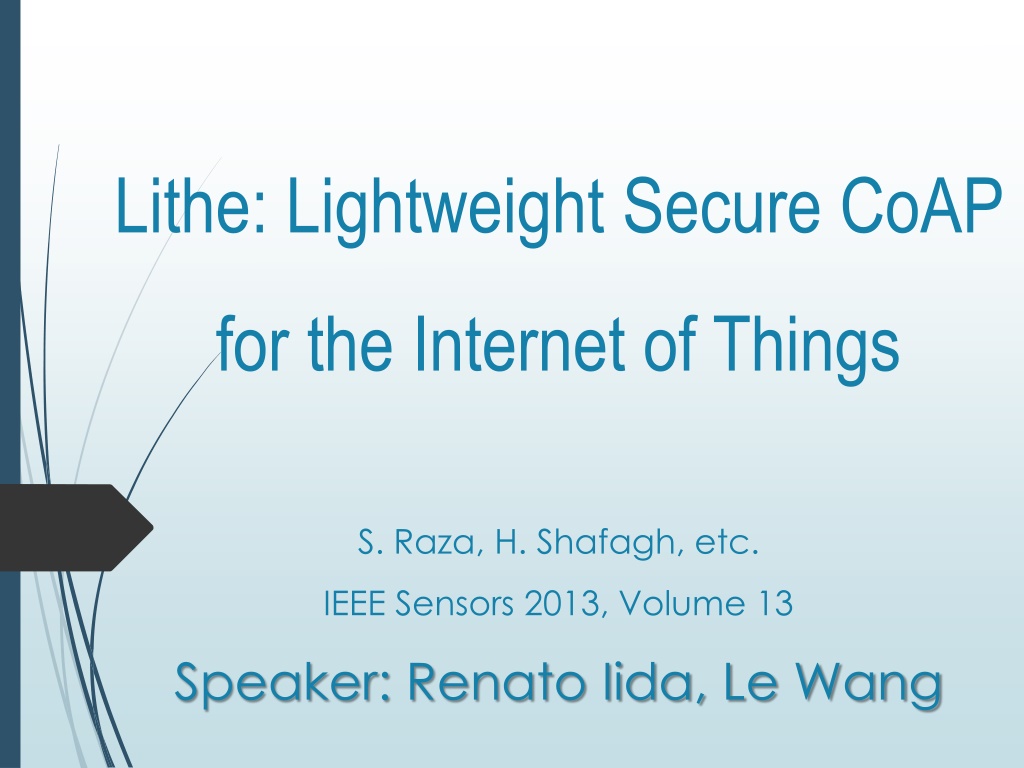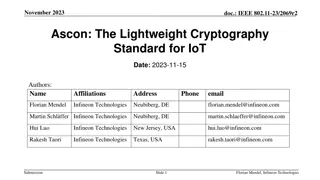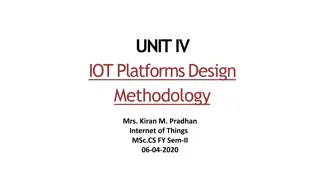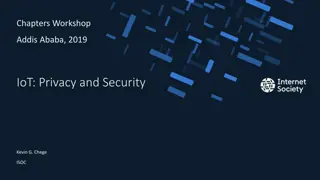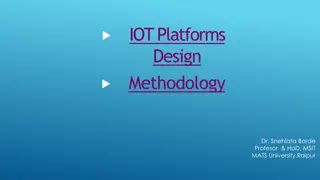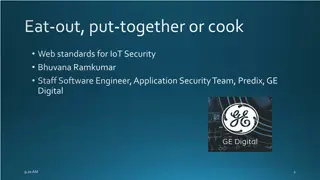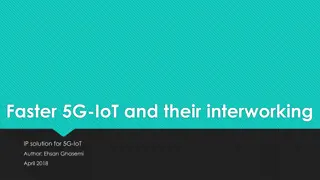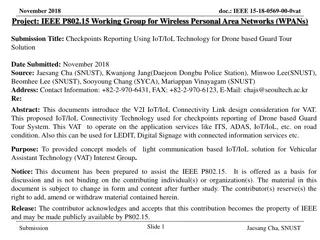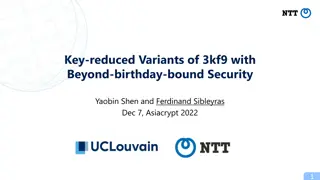Efficient IoT Communication using Lithe: Lightweight CoAP and 6LoWPAN
Efficient communication for IoT devices is crucial, and Lithe offers a solution by compressing DTLS protocol with 6LoWPAN mechanisms. This approach improves energy efficiency, reduces message size, and mitigates vulnerabilities. The integration of CoAP, DTLS, and 6LoWPAN enhances the security and performance of IoT networks.
Download Presentation

Please find below an Image/Link to download the presentation.
The content on the website is provided AS IS for your information and personal use only. It may not be sold, licensed, or shared on other websites without obtaining consent from the author. Download presentation by click this link. If you encounter any issues during the download, it is possible that the publisher has removed the file from their server.
E N D
Presentation Transcript
Lithe: Lightweight Secure CoAP for the Internet of Things S. Raza, H. Shafagh, etc. IEEE Sensors 2013, Volume 13 Speaker: Renato Iida, Le Wang
Outline Introduction Background CoAP and DTLS 6LoWPAN DTLS Compression DTLS-6LoWPAN Integration 6LoWPAN-NHC for the Record and Handshake Headers 6LoWPAN-NHC for ClientHello / ServerHello 6LoWPAN-NHC for other Handshake Messages Implementation Evaluation Packet Size Reduction RAM and ROM Requirement Run-Time Performance Conclusion 2
Outline Introduction Background CoAP and DTLS 6LoWPAN DTLS Compression DTLS-6LoWPAN Integration 6LoWPAN-NHC for the Record and Handshake Headers 6LoWPAN-NHC for ClientHello / ServerHello 6LoWPAN-NHC for other Handshake Messages Implementation Evaluation Packet Size Reduction RAM and ROM Requirement Run-Time Performance Conclusion 3
Introduction 4 6LoWPAN (IPv6 over Low power Wireless Personal Area Network) enables IPv6 in low-power and lossy wireless networks such as WSNs. 6LoWPAN defines header compression mechanisms. CoAP (Constrained Application Protocol) is designed for simplicity, low overhead and multicast support in resource- constrained environments.
Introduction 5 DTLS (Datagram Transport Layer Security) is used by CoAP as the security protocol For key management and data encryption and integrity protection. CoAPs is CoAP with DTLS support, similar to HTTPs. Problem: DTLS is inefficient for constrained IoT devices. Solution: Apply the 6LoWPAN header compression mechanisms to compress DTLS header.
Introduction: Lithe 6 Lithe: a lightweight CoAPs by compressing the underneath DTLS protocol with 6LoWPAN header compression mechanisms. To achieve energy efficiency by reducing the message size; To avoid 6LoWPAN fragmentation as 6LoWPAN protocol is vulnerable to fragmentation attaches. Lithe is the proposal solution in this paper.
E2E Communication with CoAPs 7 6BR: 6LoWPAN Border Router is used between 6LoWPAN networks and the Internet to compress/decompress or/and fragment/reassemble messages before forwarding between the two realms.
Outline Introduction Background CoAP and DTLS 6LoWPAN DTLS Compression DTLS-6LoWPAN Integration 6LoWPAN-NHC for the Record and Handshake Headers 6LoWPAN-NHC for ClientHello / ServerHello 6LoWPAN-NHC for other Handshake Messages Implementation Evaluation Packet Size Reduction RAM and ROM Requirement Run-Time Performance Conclusion 8
Background 9 Goal: To enable secure yet efficient communication among IoT devices that utilize the CoAP protocol. CoAP and DTLS 6LoWPAN
CoAP 10 CoAP is a web protocol that runs over the UDP for IoT A variant of HTTP Datagram Transport Layer Security (DTLS) is used to protect CoAP transmission. Similar to HTTPs (TLS-secured HTTP), CoAPs is DTLS-secured CoAP. Coaps://myIPv6Address:port/MyResource
DTLS 11 DTLS consists of two sublayers: Upper layer contains: Handshake, Alert and ChangeCipherSpec protocols Or application data. Lower layer contains the Record protocol Carrier for the upper layer protocols Record header contains content type and fragment fields. DTLS is between Application layer and Transport Layer
DTLS-Handshake Process 13 The handshake messages are used to negotiate security keys, cipher suites and compressing methods. This paper is limited to the header compression process only. During the handshake process the ClientHello message is sent twice. Without cookie With the server s cookie DTLS handshake protocol. * means optional.
6LoWPAN 14 Header compression IP Header Compression (IPHC) Compress Header to 2 bytes for a single hop network Or 7 bytes for a multi-hop networks (1-byte IPHC, 1-byte dispatch, 1- byte Hop Limit, 2-byte Source address and 2-byte Destination Address) Next Header Compression (NHC) Used to encode the IPv6 extension headers and UDP header. Lithe extends the NHC range to UDP payload. DTLS Layer IPHC NHC Lithe
Outline Introduction Background CoAP and DTLS 6LoWPAN DTLS Compression DTLS-6LoWPAN Integration 6LoWPAN-NHC for the Record and Handshake Headers 6LoWPAN-NHC for ClientHello / ServerHello 6LoWPAN-NHC for other Handshake Messages Implementation Evaluation Packet Size Reduction RAM and ROM Requirement Run-Time Performance Conclusion 15
DTLS Compression 16 DTLS header compression is applied only within 6LoWPAN networks, i.e., between sensor nodes and the 6BR. DTLS-6LoWPAN Integration 6LoWPAN-NHC for the Record and Handshake Headers 6LoWPAN-NHC for ClientHello / ServerHello 6LoWPAN-NHC for other Handshake Messages
DTLS-6LoWPAN Integration 17 Apply 6LoWPAN header compression mechanism to compress headers in the UDP payload. The ID bits in the NHC for UDP defined in 6LoWPAN: 11110 means the UDP payload is not compressed; 11011 means the UDP payload is compressed with 6LoWPAN-NHC. 6LoWPAN-NHC for UDP
6LoWPAN-NHC for the Record and Handshake Headers 18 After compression, the Handshake header can decrease from 12 to 5 bytes and the Record header can decrease from 13 to 3 bytes. 6LoWPAN-NHC-RHS 6LoWPAN-NHC for Record + Handshake For Handshake messages 6LoWPAN-NHC-R 6LoWPAN-NHC for Record Applied after the DTLS handshake has been performed successfully For application data.
6LoWPAN-NHC-R and RHS 19 First 4 bits represent the ID field: 1000 6LoWPAN-NHC-RHS 1001 6LoWPAN-NHC-R Version (v): DTLS version 0 omit version field (16 bits) Epoch (EC): Fragment (F): 0, 8 bit epoch is used and the left most 8 bits are omitted. 0, not fragment. Omit 2 x ( offset + length ) 6 bytes. 1, all16 bit epoch is used. 1, fragment applied. Sequence Number (SN): 0, 16 bit SN, omit 32 bits 1, 48 bit SN
6LoWPAN-NHC-CH 20 First 4 bits is ID, 1010 When the parameter is set to 0, the corresponding field is omitted. Session ID (SI): omit 8 bits Cookie (C): omit 16 bits Cipher Suites (CS): omit 16bits Compression Method (CM): Omit 8 bits
6LoWPAN-NHC-SH 22 Similar to ClientHello except: ID field is 1011 V (Server DTLS Version): 0 - DTLS 1.0, omit 16 bits
6LoWPAN-NHC for other Handshake Messages 23 The remaining mandatory handshake messages: ServerHelloDone,ClientKeyExchange, Finish have no fields that could be compressed.
Outline Introduction Background CoAP and DTLS 6LoWPAN DTLS Compression DTLS-6LoWPAN Integration 6LoWPAN-NHC for the Record and Handshake Headers 6LoWPAN-NHC for ClientHello / ServerHello 6LoWPAN-NHC for other Handshake Messages Implementation Evaluation Packet Size Reduction RAM and ROM Requirement Run-Time Performance Conclusion 24
Implementation 25 Extension to the 6LoWPAN in the Contiki OS; Hardware platform: WiSMote. Lithe implementation consists of four components: DTLS: open source tinyDTLS; CoAP: default CoAP in Contiki; CoAP-DTLS integration module: Connects the CoAP and DTLS to enable CoAPs. DTLS header compression.
Implementation 26 The 6LoWPAN layer resides between the IP and MAC layers. While applying header compression, the End-to-End security of DTLS is not compromised. .
Outline Introduction Background CoAP and DTLS 6LoWPAN DTLS Compression DTLS-6LoWPAN Integration 6LoWPAN-NHC for the Record and Handshake Headers 6LoWPAN-NHC for ClientHello / ServerHello 6LoWPAN-NHC for other Handshake Messages Implementation Evaluation Packet Size Reduction RAM and ROM Requirement Run-Time Performance Conclusion 27
Evaluation 28 Packet Size Reduction RAM and ROM Requirement Run-Time Performance DTLS Compression Overhead CoAPs Initialization CoAPs Request-Response
Evaluation - Run-Time Performance Radio Duty Cycling (RDC) 31 With RDC, the radio is off most of the time and is turned on either in certain intervals to check the medium for incoming packets or to transmit packets. Duty cycled MAC protocol, X-MAC Metrics: Energy consumption Energy estimation module in Contiki OS Conversion from absolute timer values to energy: Network-wide round trip time (RTT)
Evaluation - Run-Time Performance DTLS Compression Overhead 32 The overhead caused through in-node computation for compression and decompression of DTLS headers is almost negligible. CH ClientHello CH(C) ClientHello with Cookie CKE ClientKeyExchange HV HelloVerify SH ServerHello SHD - ServerHelloDone Additional Energy Consumption for Compression of the Handshake Messages. For a DTLS handshake based on pre-shared keys, 4.2uJ of energy is consumed for compression
Evaluation - Run-Time Performance CoAPs Initialization The tradeoff between additional in-node computation vs. reduced packet sizes shows itself in the energy consumption for packet transmission in a DTLS handshake. 33 15% less energy is used transmit/receive compressed packets.
Evaluation - Run-Time Performance CoAPs Request-Response Once the CoAPs initialization phase is completed, i.e., the handshake has been performed, a sensor node can send/receive secure CoAP messages using the DTLS Record protocol. 34 Metrics Energy consumption RTT
Evaluation Energy Consumption 35 The Energy Consumption from Client/Server w/out RH Compression The Energy Consumption from the sum of Client/Server w/out RH Compression
Evaluation Round Time Trip (RTT) 36 Pure CoAP Comparison of RTT for Lithe, CoAPs and CoAP
Outline Introduction Background CoAP and DTLS 6LoWPAN DTLS Compression DTLS-6LoWPAN Integration 6LoWPAN-NHC for the Record and Handshake Headers 6LoWPAN-NHC for ClientHello / ServerHello 6LoWPAN-NHC for other Handshake Messages Implementation Evaluation Packet Size Reduction RAM and ROM Requirement Run-Time Performance Conclusion 37
Contribution 38 The first paper to propose 6LoWPAN compressed DTLS and enable lightweight CoAPs support for the IoT. Provide novel and standard compliant DTLS compression mechanisms that aim to increase the applicability of DTLS and, thus, CoAPs for constrained devices. Implement the compressed DTLS in an OS for the IoT and evaluate it on real headware; Lithe is more efficient compared to uncompressed CoAP/DTLS.
